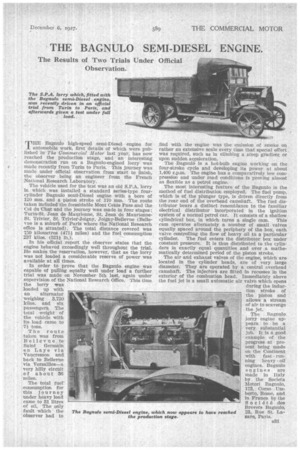THE BAGNULO SEMI-DIESEL ENGINE.
Page 57

If you've noticed an error in this article please click here to report it so we can fix it.
The Results of Two Trials Under Official Observation.
• r liE Bagnulo high-speed semi-Diesel engine for _L automobile work, first details of which were published in The Commercial Motor last year, has now reached the production stage, and an interesting demonstration run on a Bagnulo-engined lorry was made recently from Turin to Paris. This journey was made under official observation from start to finish, the observer being an engineer from the French National Research Laboratory.
The vehicle used for the test was an old S.P.A. lorry in which was installed a standard series-type fourcylinder Bagnulo semi-Diesel engine with a bore of 120 mm, and a piston stroke of 170 mm. The route taken included the formidable Mont Cenis Pass and the Col du that and the journey was made in four stages: Turin-St. Jean de Maurienne, St. Jean de MaurienneSt. Trivier, St. Trivid-Joigny, Joigny-Bellevue (Bellevue is a suburb of Paris where the National Research office is situated). The total distance covered was 759 kilometres (4711 miles) and the fuel consumption 237 kilos. (5211 lb.).
In his official report the observer states that the engine behaved exceedingly well throughout the trial. He makes the reservation, however, that as the lorry was not loaded a considet able reserve of power was available at all times.
In order to prove that the Bagnulo engine was capable of puffing equally well under load a further trial was made on November 5th last, again under supervision of the National Research Office. This time the lorry was loaded up with an alternator weighing 3,720 kilos. and six passengers. The total weight of the vehicle with Its load came to 7-k tons.
The route taken was from Bellevue to Saint Germain en Laye via Vaucresson and back to Bellevue via Versailles—a very hilly circuit of about 36 miles.
The total fuel consumption for this journey under heavy load came to 31 litres or oil. The only fault which the The Bagnulo semi-Diesel engine, w observer had to
find with the engine was the emission of smoke on rather an extensive scale every time that special effort was required, such as in climbing a steep gradient or upon sudden acceleration.
The Bagnulo is a hot-bulb engine working on the four-stroke cycle and developing its power at about 1,400 r.p.m. The engine has a comparatively low compression and under road conditions is proving almost as flexible as a petrol engine.
The most interesting feature of the Bagnulo is the method of fuel distribution employed. The fuel pump, which is of the plunger type, is driven directly from the rear end of the overhead camshaft. The fuel distributor bears a distinct resemblance to the familiar electrical distributor incorporated in the ignition system of a normal petrol car. It consists of a shallow cylindrical box, in which turns a single cam. This cam operates alternately a number of small valves . equally spaced around the periphery of the box, each valve controlling the flow of heavy oil to a particular cylinder, The fuel enters the distributor box under constant pressure. It is thus distributed to the cylinders in exactly equal quantities and over a mathematically determined period of the piston stroke.
The air and exhaust valves of the engine, which are located in the cylinder heads, are of very large diameter. They are operated by a central overhead camshaft. The injectors are fitted in recesses in the exterior of the combustion head. Immediately above the fuel jet is a small automatic air valve which opens during the induction stroke of the piston and allows a stream of air to scavenge the jet.
The Bagnulo lorry engine appears to be a voery. It isag ocd lb example of the progress at present being made on the Continent with fast running heavy oil engines. Bagnulo engines are made in Italy by the Societa. 3lotori Bagrmlo, 173, Corso Umberto, Rome, and In France by the Soci 6te des Brevets Bagnulo, hich now appears to have reached 23, Rue St. Lazare, Paris.




















































































































